GOLDEN AGE
by Steve Bloom
Steve Bloom is the author of Video Invaders. He freelances on music for Downbeat, Musician and The Record.
During the first golden age of video games, from 1972 to 1978, American engineers, entrepreneurs and manufacturers set the stage for the phenomenal period that brought Space Invaders, Pac-Man and Donkey Kong. Ironically, the Americans would yield to the Japanese in this second golden age, but without their pioneering efforts this new territory would never have been charted.
In the Beginning
Seventy-two years old as of this writing, and still active at the Brookhaven National Laboratory in Upton, New York, Willy Higinbotham is more than deserving of his title "grandfather of video games." In 1958 it was he who designed the first video game ever, simply to entertain visitors to the Brookhaven labs.
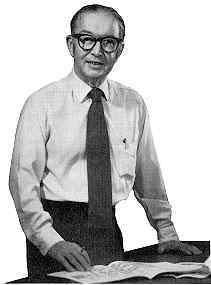
William Higinbotham, grandfather of video games.
Using an analog computer with a radar screen and paddle-type controllers connected to it, Higinbotham and his associate Dave Potter developed a method for simulating tennis. The object was to maintain a volley for as long as possible by swatting a ball with one of the two rackets that appeared on either side of the screen. A line down the middle indicated the net; gravity, wind speed and bounce were calculated into the game play. Since Brookhaven is primarily involved in defense research, Higinbotham never bothered to secure the patent for his invention. "We knew it was fun and saw some potential in it at the time," he told Creative Computing, "but it wasn't something the government was interested in. It's a good thing, too. Today all video game designers would have to license their games from the government!"
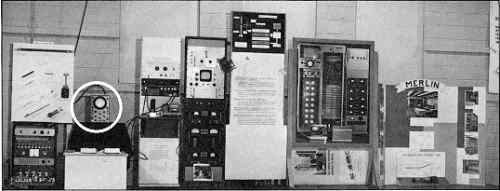
Brookhaven's Merlin: the first video game console. Tennis was played on an oscilloscope screen (circled.)
Fourteen years later, the patent that would protect all "ball-and-paddle" games was issued to Sanders Associates of Nashua, New Hampshire, a Fortune 500 research firm. Sanders project engineer Ralph Baer clearly had a vision. "I have an official entry in my notebook, dated September 1966," Baer says, "that talks about what one might do with a TV set other than turn it on and off. It's a powerful display, a marvel of technology. My whole thrust was toward doing something with the TV set that people could afford. That's when the thought of playing games came along."
For the remainder of 1966 Baer spent all his spare time working on the elementary circuitry for his imaginary video game system. By December he had spots chasing around on a TV screen, and that was when he decided "this thing was too important to handle on an after-hours, casual basis." Corporate research at Sanders designated it an "official project," and Baer was set up in a room off-limits to everyone but himself and co-workers Bill Harrison and William Rusch.
"Early in 1967," Baer continues, "we had the most basic ball-and-paddle games working. By September we were playing hockey games that were rather fancy, meaning the ball motion was complicated. Velocity, for instance, depended on how hard you hit the puck-it had all the dynamics of a real puck. So now we had all this stuff, but there was one question we couldn't answer: what the hell do we do with it?"
Most of the TV manufacturers were mildly interested, but not enough to buy a piece of this newfangled product. Then, early in 1970, Magnavox flew Baer out to its corporate headquarters, where he encountered a roomful of hostile company engineers. "They all thought it would be next to impossible to create a TV-game system at a reasonable price," says Baer. "But Jerry Martin, the V .P. of marketing at the time, said, `We're going with it.' That was the day you could say the Odyssey 100 was born."
Introduced in the fall of 1972, Baer's Odyssey 100 went on to sell more than a hundred thousand units. A plastic white box with switches and knobs on the outside and "basically 40 transistors and a pile of diodes" inside, the world's first home video game, by today's standards was nothing less than prehistoric. For $99 you received the console; two controllers; a selection of maze, chase and sports games; and Mylar overlays colored with backgrounds that you were instructed to tape over the TV screen.
"You couldn't have anything more complex than a line down the middle of the screen for a net, and paddles and balls," Baer explains. "Generating complex backgrounds then was out of the question price-wise. And scoring was just too damned expensive." In other words, you had to keep score yourself.
Odyssey 100 sales began to falter in 1973, due to poor marketing, advertising that implied you could only play the game on a Magnavox, the fear that constant use would damage the picture tube and competition. By 1976 there would be more than seventy TV-game manufacturers jockeying for position, including an upstart named Atari.
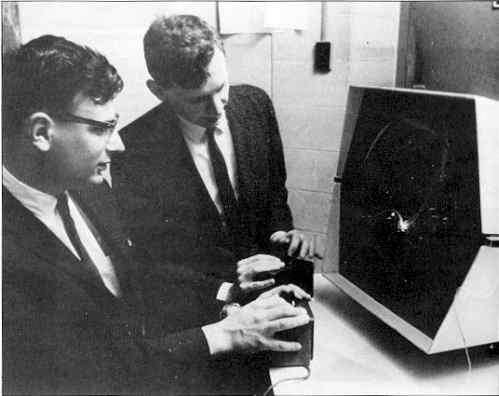
Spacewar was played with the earliest computer joysticks.
Atari Roots
Back in 1961 some of M.I.T.'s best and brightest computer hackers had programmed the cosmic clash of video titans known as Spacewar on a PDP-1 mainframe computer. Heretofore, mainframes had been incredible hulks, virtually impenetrable for even the most obsessed hacker. According to J. M. Graetz, a contributor to Spacewar, the PDP-1 was an entirely different story. It was the first computer that almost anyone could turn on and run.
Graetz and his fellow hackers were into more than computers at the time. Edward E. Smith's science-fiction epics, such as The Skylark of Space, were regular reading material, and a diet of Japanese cinema fangoria (Rodan, The Mysterians, Godzilla) was required late-night viewing. When the PDP-1 arrived, complete with a CRT (or TV screen), Graetz and Steve Russell, who would write the original game program, let out this simultaneous cry: "SPACEWAR!"
"The basic rules developed quickly," Graetz recalled in Creative Computing. "There would be at least two spaceships, each controlled by a set of console switches. The ships would have a supply of rocket fuel and some sort of weapon: a ray or beam, possibly a missile. For really hopeless situations, a panic button would be nice. And that, pretty much, was that."
Actually, there was more to Spacewar than met the eye. Opposing players sniped at each other's spaceship for points while steering clear of the "heavy star," or black hole, that could suck you into videoblivion. Another subtler feature was the star field, including constellations based on data found in the American Ephemeris and Nautical Almanac. The control boxes had two levers (one moved left-right for rotation, the other moved forward/thrust, back/hyperspace) and one button (torpedo fire).
Spacewar debuted at M.I.T's annual Science Open House in May 1962, and before long every computer science and electrical engineering student worth his salt was playing one of the many versions of the game that spread from campus to campus during the 1960s. Always fascinated by games, Nolan Bushnell discovered Spacewar at the University of Utah and was quick to recognize that here was a revolutionary conceptinteracting with blips of light on a TV-type screen-whose time had not yet come.
Bushnell's first job after graduating was at Ampex, a Silicon Valley concern where by day he toiled in the advanced technology division. By night he tinkered in the family garage with what would become the world's first commercial video game. The year was 1969, and the price of integrated circuits was dropping rapidly. Suddenly it was feasible to bring Spacewar to the arcades.
Back then a typical arcade featured a cross section of pinball machines, driving games and rifle shoots, a score of skee-ball lanes and perhaps an old-fashioned mechanical crane or two (object: dig for prizes). Bushnell's Computer Space game looked like it had been cooked up in a mad computer scientist's workshop. The cabinet-blue, with curved lines and with the CRT recessed inside an oblong opening-was part art deco, part space age. The game itself resembled Spacewar but was lacking in mainframe complexity. First of all, Computer Space was a misnomer, since it had little to do with computers (though a lot to do with space). The circuitry could by no means duplicate Spacewar's, limiting the game play and special effects. In place of the fine vector graphics of the original, Bushnell substituted more conventional rasterscan images (vectors are simply lines, whereas rasterscan paints solid areas of color), and the resulting graphics were crude by anyone's standards.
Like Spacewar, the game was a kind of Buck Rogers galactic gunfight that would constantly reappear in video game design straight into the 1980s. In that light it's probably fair to accept Bushnell's claim that Computer Space was "ahead of its time," especially considering the difficulties he faced in getting it into arcades. "Marketing Computer Space was tough," says Bill Nutting, whose firm Nutting Associates built fifteen hundred of them. "The more progressive-minded arcade operators took it, the others didn't. I think we blew the industry's mind."
With $500 in royalties from Computer Space, Bushnell went ahead and formed Atari. He hired Al Alcorn, an engineer at Ampex, and as a training exercise had him work up "the simplest game I could think of. The game I was striving for was a driving game, but I felt he wasn't ready for that yet. So I described Pong instead. Basically, I felt it was a throwaway; however, he engineered it and the game turned out to be a lot of fun, so we decided to market it on the way to the driving game. I guess you could say Pong was a mistake."
Pong was the simplest form of video game, and a tremendous, outrageous, runaway success. The story goes that Bushnell placed the first Pong machine in Andy Capp's, a bar in Sunnyvale, California, sometime in the middle of 1972. During its second day on test Bushnell received a call from the owner, who complained that the game had gone on the blink. He raced right over, opened up the cabinet and located the problem: too many quarters in the machine.
Pong's two-player format, tapping the public's traditional competitive spirit, invited spectators, wagering and general raucous behavior. It was "easy to learn, but difficult to master"-Bushnell's gaming credo. Literally dozens of imitations (Allied Leisure's Paddle Battle and Midway Manufacturing's Winner, to name just two) infiltrated the arcades, while at home people were playing Odyssey 100 and would soon have the chance to sample Atari's home Pong varieties.
And what about mild-mannered Ralph Baer, whose "ball-and-paddle" patent anteceded Pong by six months in 1972? "Pong was a derivative of Odyssey, not the other way around," Baer contends. "Bushnell or one of his boys actually saw the Odyssey 100 sometime during the course of 1972. It's a matter of record." By this he means that his employer, Sanders Associates, and Atari subsequently settled the matter out of court as Atari agreed to license Baer's invention through Magnavox.
A dozen years later, the controversy having died down somewhat, Bushnell is singing Baer's praises. "He did some really good pioneering work in the analog field. A lot of the work he was doing came before many of the integrated circuits that made my life very easy. He's a very bright man." Meanwhile, Baer is modest enough to admit that Bushnell was "the catalyst" for the video game industry. "If he hadn't come along with Pong," Baer says, "I think the whole thing would have gone down the drain."
End of an Era
Over the next few years innovation slowed to a crawl as mundane gun battles like Midway's Gunfight and Atari's Tank replaced Pong and its relatives in the arcades. These games were slow-moving, unrealistic contests that drove the new generation of players right back to pinball.
It wasn't until 1976 that video games were back in the headlines. Remember Death Race, where the object was to mow down innocent pedestrians who happened to be strolling in your path? The National Safety Council called it "sick, morbid and insidious"; 60 Minutes probed the psychological significance of it all. The only thing to be learned from Death Race was how little progress the industry had made since Pong.
By 1978 the first wave of video games came full circle. An M.I.T. graduate named Larry Rosenthal decided to re-create the vector display that had given Spacewar its otherworldly appeal. He then designed a control panel that could accommodate all the game options he could think of: left and right rotation, thrust, fire and hyperspace (just like the original, except that it used levers); a choice of six game levels, from novice to expert; and five terrific modifications-bounce-back, expanded universe, black hole, negative gravity and no gravity. With all these buttons you had to be a magician or at least a pianist to play the game, but Cinematronics, a newcomer on the scene out of San Diego, patented the hardware system (Vectorbeam) and called the game Space Wars. It became the arcade hit of the year.
But America's domination of the video game business was about to come to an end. A few domestic games would continue to score well with the public, such as Atari's Asteroids and Centipede, and Williams Electronics' Defender, but the Japanese takeover was already underway. While American games grew more difficult to learn, impossible to master (exception: Asteroids), Japanese design teams'stole a page from Nolan Bushnell's notebook. "Easy to learn, difficult to master," they repeated like a mantra. Bowing politely to another example of American ingenuity, the Japanese made sure that the second golden age of video games would be all theirs.
| BUSHNELL'S LOST ARCADE CLASSICS Though he is credited with being the father of the video game, Nolan Bushnell has also had his share of arcade breakthroughs that went unrecognized, often appearing well before their time. • Computer Space (1970). The first commercial arcade video game. Like the campus Spacewar game, you controlled a spaceship and gunned for the opposing ship. Unlike Spacewar, this game was played against the machine, not a human opponent. • Space Race (1973). The object was to slither through an obstacle course, starting at the bottom of the screen and ending up at the top. Sound like Frogger? You guessed right. • Gotcha (1973). The original video maze game. PacMan it wasn't; money it didn't make. • Dr. Pong, a. k. a. Puppy Pong (1974). Take Pong, put it inside a cabinet like Snoopy's dog house and sell it to doctors for waiting room use. Unfortunately, the medical community wasn't buying. Word is, Snoopy's creator wasn't too crazy about the idea, either. • Jaws (1975). Those were the days when you could base a game on a popular concept (in this case, the movie) and get away without paying for it. Basically, you were the diver; the machine, the shark. A clever idea, but not much of a game. • Triple Hunt (1977). An old-fashioned rifle shoot with three games: Hit the Bear, Witch Hunt and Raccoon Hunt. Somebody forgot to tell Atari that rifle shoots had become passe with Pong. • Avalanche (1978). Catching falling rocks with a bucket or paddle never caught on in arcades, but was a success when redesigned by Activision as Kaboom. S. B. 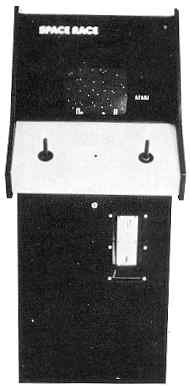 Space Race: the forerunner of Frogger. |
THE JOYS OF JOYSTICKS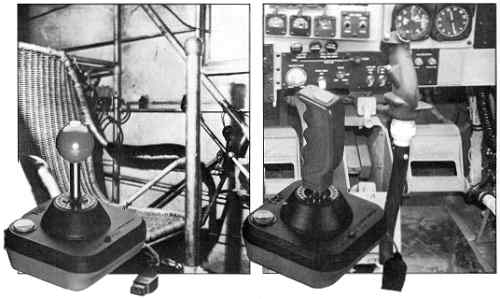 To experienced computer gamers, the qualities to look for in a joystick are good motion, sensitivity, durability and fit. Its innards are relatively simple, no more than electrical switches detecting changes in any of eight directions or variable resistors indicating proportional movement along two axes. Computer joysticks are so named because of their resemblance to the control sticks used on early airplanes. Above are joysticks from the cockpits of Charles Lindbergh's Spirit of St. Louis and a World War lI fighter; insets show their modern-day counterparts. On the horizon: wireless joysticks and line-of-sight targeting, as well as game controllers with tactile feedback from on-screen encounters. |
| HOW COMPUTER GAMES SAVED MY LIFE The debate over the social effects of video games often founders on the issue of such games' applicability to real life. "They only teach kids how to shoot down aliens from outer space or gobble up power dots," goes the usual argument. Well, playing computer games can quite literally save your life, and I'm here to prove it. But first a word about Donkey Kong. Created by Nintendo of Japan and popular throughout the world, Donkey Kong came to U.S. shores too late in the video arcade craze to gain the notoriety accorded Space Invaders and Pac-Man. The press took little notice. The only success it attained was among its players in the arcades. Yet it spawned not only its own sequels-Donkey Kong Jr. and Mario Bros.-but also the countless clones in personal computer software that include best sellers like Jumpman, Miner 2049'er and Lode Runner. The key to Donkey Kong's appeal can be found in its representation of a human figure as protagonist-a first in a major arcade game. Mario, the mustachioed hero, is trying to rescue the pretty girl from the clutches of the gorilla at the top of the screen. To get to the top, Mario must climb ramps and ladders and leap over obstacles along the way. It is Mario's ability to jump at the push of a button that has given Donkey Kong and its ilk the genre designation "jump games." Mario is a modern-day Sisyphus, eternally trying to make it to the top of his hill, only to find himself condemned to start all over again at the bottom. In his own way, Mario offers a more enduring symbol for the human condition than the legions of quasi-heros to be found in current fiction. I realized all this after a visit to my local dry cleaning shop. While leaning over the counter as the owner filled out my name and address on the claim ticket, I suddenly heard something like the sound of falling rain. I looked around and caught a glimpse of mayhem hurtling toward me. As if at the push of a button, I found myself leaping away, Mario-style, as a pizza-size chunk of ceiling landed exactly where I'd been standing. Honed by hours of computer game play, my reflexes had caused me to jump out of the way of possible injury-or death. So while the debate over video games continues to rage, I can only thank the lucky stars that put a computer on my desk and a joystick in my hands. STEVE DITLEA |
| GAME GRAPHICS Ever wonder how computer game designers get those eye-popping displays on-screen? Graphics on large computers are normally done with a system called a "bitmap," a collection of bits that tells the computer what color each tiny dot on the screen should be. However, bitmaps tend to consume a great deal of memory. Because they're so big, calculations with the screen image take a lot of computer time, and this slows down animation effects. To solve these problems, several home computers use four clever tricks built into their hardware to get around the limitations of bitmap display. 1) Sprites, or players, are tiny bitmaps that can be moved easily around the screen. If you imagine a computer screen to be like a large piece of paper, then a sprite is like a small piece of paper that lies on top of the larger piece. The advantage of the sprite comes when you want to move the image around. Instead of erasing the old image and redrawing it piece by piece a little to the left, you need only slide the sprite image a little to the left. When you see a computer screen with mostly dull background but a few little images flying madly around the screen, you know you're seeing sprites. 2) Color registers are memory locations that store color codes for the screen display. Programmers using color registers need not mess with, say, 236 colors at once. If you want to put a maroon spot on the screen, you simply tell the computer to put color #3, for example, onto the screen. Then you go to color register #3 and store the number 236 (the code for maroon) inside. One advantage of the color register is that it's a lot easier to use a few small numbers than a lot of big ones. Another is that you can change the color registers quickly to get a scintillating explosion of color. 3) Redefinable character sets are collections of shapes that normally make up letters. Thus, when you tell the computer to put a letter `A' onto the screen, it has to look up a collection of bits that tells it what an "A" looks like. A computer with a redefinable character set allows you to sneak in and change those collections of bits. This way, when you tell the computer to display a letter "A," it might instead create a little spaceship. The redefinable character set is much faster for drawing a repetitive image. If you wanted fifty spaceships on the screen, you would not laboriously draw each ship; you would just command the computer to put fifty `A's on the screen. 4) The fine scrolling register allows programmers to slide the entire screen by a tiny step. The step is so tiny that you would never notice it, but when you slide the screen many times this way, you see the entire image scroll smoothly. The same trick with a bitmap would require you to recompute all the bits for each tiny step of motion, and the process would take up so much time that it would look slow and jerky. These four tricks, the most common techniques used to magnify graphics power, make it possible for home computers to do things that only very expensive bitmapped computers could do. CHRIS CRAWFORD |
Return to Table of Contents | Previous Article | Next Article

